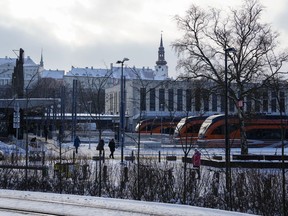
Article content material
HELSINKI (AP) — Estonia, Latvia and Lithuania mentioned Saturday they’re dedicated to finishing by the tip of the last decade a financially troubled and badly delayed high-speed rail undertaking integrating the three Baltic international locations with the continental European rail community.
Set to hyperlink the Baltic capitals of Tallinn, Riga and Vilnius on a brand new observe with passenger trains working at speeds of as much as 250 kph (155 mph), the Rail Baltica undertaking was launched in 2014 as a pan-Baltic three way partnership with financing primarily supplied by the European Union.
Commercial 2
Article content material
Vladimir Svet, the Estonian infrastructure minister, mentioned Saturday after an earlier assembly with the Latvian and Lithuanian transport ministers that “it’s nonetheless our aim to begin passenger and freight practice visitors on the whole Rail Baltica route from 2030.”
“Nevertheless, we nonetheless need to control the expansion of prices and discover methods to save cash and construct extra effectively,” he mentioned in an announcement.
Whereas the preliminary 2010 plan noticed the undertaking’s whole value at round 3.5 billion euros ($3.9 billion), a June joint report by auditors from the three Baltic states showcased the enterprise’s ballooning prices and mentioned the undertaking may have as much as 19 billion euros ($21 billion) extra funding to be accomplished.
It’s unclear how a lot the EU, which has recognized Rail Baltica as one of many key European transport initiatives, is prepared to inject cash into the enterprise.
Building of recent rail observe, working a complete size of 870 kilometers (540 miles) from Tallinn, Estonia to Kaunas, Lithuania and onward to the Polish border, began in 2019 however has been marred by delays and disputes between the Baltic governments of the practice’s routing.
Article content material
Commercial 3
Article content material
The enterprise is working not less than 5 years behind as the primary pan-Baltic passenger and cargo trains have been supposed run on the brand new tracks in 2025.
Critics of the undertaking say the meager inhabitants base within the Baltics — simply over 6 million folks reside within the three Baltic states _ makes the undertaking economically unfeasible for passenger journey and its emphasis ought to be extra on cargo, additionally a key component within the enterprise.
Estonia, Latvia and Lithuania, all former Soviet republics, inherited the Soviet rail infrastructure system and the broader Russian gauge of 1,520 mm rails, once they regained their independence at first of the Nineteen Nineties.
“The Rail Baltica undertaking is a symbolic return of the Baltic States to Europe — till the Second World Warfare the Baltic States have been already related to Europe with 1,435 mm broad (gauge),” the Rail Baltica web site says.
“However because the center of the twentieth century the Baltic international locations have been primarily linked to an East-West railway axis utilizing the Russian gauge 1520 mm rails,” it mentioned.
As soon as accomplished, the high-speed practice is about to cowl the 660 kilometer (410 mile) journey from Tallinn to the Lithuanian capital, Vilnius, in 3 hours and 38 minutes, providing a considerable time financial savings to the present automobile or bus experience of as much as 9 hours.
Commercial 4
Article content material
With extra rail connections, the north-south Rail Baltica will join the Baltic states with Warsaw, Poland and, ultimately, Berlin — a key goal of the Baltic governments.
Because of the modified geopolitical state of affairs in Baltic Sea area following Russia’s full-scale invasion of Ukraine, Estonia, Latvia and Lithuania — all sharing border with Russia — are stressing that the necessity to spend money on infrastructure, which allows quick and enormous portions of navy gear to be transported, has grown considerably.
Finland, strongly linked to Estonia by quite a few ferry connections from Helsinki to Tallinn by the Baltic Sea, is not directly concerned within the enterprise.
Article content material




